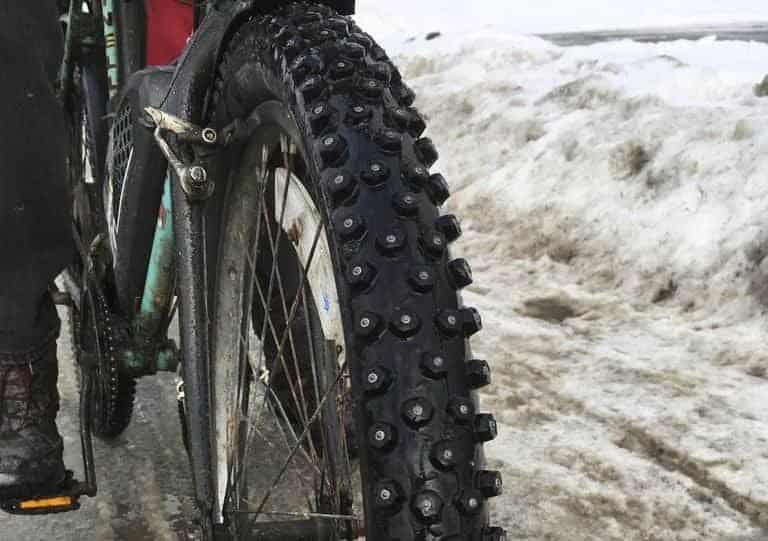Last Updated on January 9, 2023 by Igor Karni

Winter remains a perennial worry for most e-bike riders for a good number of reasons. In fact, it simply would not do to ignore the snowier months because doing so would have dire consequences for an e-bike owner.
Even electric bikes that are designed to handle colder climates should never be considered as being fully resistant to frosty (and dirty) elements. The mere fact that winter weather can be very unpredictable only makes it all the more necessary to be extra vigilant.
That said, any person who asks, “Can I ride an electric bike in winter?” will certainly need not worry about being answered in the negative. Yes, you can definitely ride your e-bike in winter. Even if snow has piled up on the roads and conditions are wetter and more slippery than usual. You only need to be willing to take the time to prepare yourself and your e-bike for those weather conditions.
You will, for instance, need to be a bit more mindful of the e-bike’s battery, which has proven to be particularly vulnerable to freezing. Since the e-bike would be exposed to moisture consistently as well, you would have to be wary of rusting too and keeping your electric bike cleaned as well. Furthermore, proper storage would have to be considered as well.
Read also: What is the best way to store an e-bike? And, How to prepare an e-bike for winter?
As far as riding is concerned, on the other hand, most of the preparation focuses on ensuring your overall safety while riding and in mitigating any potential damage to your electric bike. This might include reinforcing your tires, wearing protective clothing, and other preparation details.
Why winter is a common issue for e-bikes and e-bike riders
Winter, regardless of your location, brings with it extreme (on not so extreme) cold and wetness that can bring about undesirable conditions for any electric device, including an e-bike. This is true even if the product is purported to be “snow resistant”.
You can never be sure, after all, of how low temperatures can drop once the snowy season rolls in. This particular risk cannot be more apparent in e-bike owners who report having e-bikes that take longer than usual to charge and have rust issues after being stored overnight in extremely cold conditions.
Lithium-ion batteries, a common battery, usually utilize lithium plating, which is vulnerable to stressful conditions like that. These batteries also tend to fail to charge (because of the possibility of the cells getting permanently damaged) or take so long to do so if they are subjected to temperatures below freezing levels (0°C or 32°F).
Easy Tip: This underscores the need to keep your e-bike warm in whatever room you choose to store or charge it.
Conversely, riding is also a herculean challenge. In fact, many people would probably advise you to refrain from taking your electric bike out for a ride in winter. And that is pretty sound advice. However, that is not to say that you should forego riding your e-bike altogether.
At most, it is all about knowing whether the conditions are safe enough for riding. Besides, more advanced e-bike models have also evolved enough to the point that they could easily handle dangerous road conditions like icy, muddy, and snow-covered paths.
Read also: Can e-bikes get wet? And, How to clean an electric bike?
Of course, that is only half the equation. Riders would also have to take precautions in ensuring their safety and protection from the cold elements. Without adequate winter clothing, your chances of catching a cold (or something worse) just rise exponentially.
Proper maintenance of e-bikes during winter
In addition to the obvious importance of preventing the battery from getting damaged, there are numerous other factors to remember to prevent your e-bike from encountering the usual issues said above. Once you learn them and invest time in doing them every winter comes around, you will always be a step ahead of those problems.
Keeping the e-bike battery warm
With regard to storing your e-bike, you should pay close attention to temperature levels in the room and how it tends to change. It is important for you to, at least, come up with effective ways to keep the storage temperature of the battery between 15 to 20°C (59 to 68°F).
We specifically mentioned the battery; this is because we highly recommend that you remove the battery after every time you use your e-bike then store it in a place that will be able to maintain those ideal temperatures. Most indoor rooms can easily achieve those ideal temperatures, so this really should not be a problem.
Every time you charge the battery, make sure that you do so only at room temperature. Anything below that or if the temperature is below freezing levels raises the risk of damaging its inner cells. Just be sure to get it all warmed up first before plugging it in.
A lot of users tend to rely on a heater for this, which is NOT at all a smart idea. You should also pay attention to the battery terminal before setting the battery again. Make sure it is just as dry and not too cold.
Read also: What is the difference between e-bike batteries? And, How far can e-bikes go? What is the e-bike range?
When riding the electric bike, you need not worry too much about damaging the battery even if temperatures go below zero. However, do not be surprised if the riding range would be significantly reduced and for its power to be weakened as well.
The key is to keep the battery’s temperature as high as possible. Most of the time, this can be achieved by adopting the habit of bringing it indoors after each ride.

Other winter e-bike maintenance guidelines to keep in mind
Rust due to salt (commonly placed on roads during winter) or moisture can be easily addressed by using sprays that make it rustproof. These sprays are readily available in most auto stores. You only need to spray them on each part of the e-bike where the metals have a tendency to be exposed to the said elements.
You do not need to apply these sprays regularly, as they are applied as lasting coatings. Once used, you can expect them to still provide their protective benefits once spring arrives.
Riding through a lot of dirty tracks where mud, dirt, and other debris can easily cling to your electric bike needs to be considered as well. For this, you might have to be prepared to always clean your e-bike every time you ride it. That said, only clean your bike at warm, room temperature as well.
Learn the exact lubricant that is ideal for the electric bike then use a damp cloth to get rid of any unwanted filth that got stuck to it. It should not be hard to clean with the right lubricant, and you have to make it a point to apply the lube often.
Read also: Why fat tires are good news for electric bikes? And, How to select the best hybrid e-bike?
In most cases, it is recommended to use lighter, wet lubricants during winter because they can reach the chain better and rid it of all dirt and filth. Be mindful of the chain because it tends to depreciate faster during the colder months. You may need to lubricate it often because of this.
Wash off any of the salt that may have clung to your bike after riding; these will really start to damage your bike otherwise (assuming you are not using the sprays mentioned above).
Resist using any kind of pressure washer on your bike because it is not ideal if your electric bike has been recently exposed to the cold. Use something that will not be too strong, like a sprayer with adjustable pressures.
If it happens to be a good day and the sun is peeking, by all means, take your bike outside and do the cleaning there. You can even let it dry in the sun. Of course, this is assuming the temperatures are not at or below freezing levels.
E-bike riding tips during the cold season

In the same way that you should take extra care of your electric bike in the winter, you should also be uncompromising when it comes to your safety every time you take it out for a ride.
This is especially true if you tend to take it through rougher, off-road terrains. Oftentimes, this entails gearing up with special apparel and fastening your electric bikes with extra protection ideal for winter conditions.
Use tires specially designed for winter riding
Emphasis on winter tires is a must here. Some users opt for tires that are only suitable for rain. But they will soon find out that snow is an entirely different beast that will render their tires useless.
Do not make the same mistake. Winter tires for electric bikes are resistant to the effects of cold temperatures. This allows them to avoid any of the usual issues of the tire’s rubber stiffening as a direct result of it.
That said, be prepared to shell out a bit of money for these specialized tires. Even so, they are well worth the investment because of their undeniable benefits. Rimmed, tough winter tires that can withstand puncturing will suffice for plenty of cases.
However, if you also tend to ride through heavy snow, consider buying studded varieties as well. These kinds of tires can plow through that snow and ice with relative ease. Almost any area where temperatures drop to below freezing levels should be ridden through with studded tires as much as possible.
They are not without downsides, though, as they might take a toll on your e-bike’s speed and riding range. Always be mindful of this when calculating the amount of time you will spend riding.
Read also: Selection of our favorite e-bike accessories to help you find the right gear for your needs.
Always check your brakes
This is a fundamental step for anyone who wishes to ride out in tracks and roads that are wetter and colder than usual. The fact that freezing temperatures may cause your brakes to work less efficiently makes this all the more necessary.
This is why it is always advised to take the time to check it and the shifter before you take your bike for a ride. Give them a good prepping, check the cables for any sign of freezing or moisture accumulation. In addition to this, you may also have to fit it with new, better brake pads.
Check the brake’s levers too. Does it still manage to help you maintain a good grasp on it even if it is already wet? If your hands tend to slip, you have to put some tape with sandpaper on it to help you maintain a good grasp and prevent any form of slipping.
Read also: What is regenerative braking on electric bicycles? Is it worth it? And, Do e-bike riders switch the power up and down as they ride?
Put protective fenders on your e-bike
You never know when that snow might start to build and begin to get all over your face. For this, front fenders will certainly provide you with much-needed protection from these inconveniences while out and about with your e-bike. Back fenders are also available to prevent snow from ending up on your back.
Wear proper winter e-bike riding gear

There are certain winter clothes, apparel, and equipment specifically designed for e-bike riders. And each one was created to fulfill a specific purpose. This is why you should not consider skipping a single one, especially those that will give you sufficient protection from the cold.
It is best to be fully geared once you face unpredictable winter conditions to ensure safety and avoid potential hurdles on the road.
Face protection
For the face, consider putting on anti-glare sunglasses or ski goggles. Your vision significantly improves with this special eyewear on. Not to mention the fact that they also keep snow and debris from interfering with your eyesight. Of course, since they are also anti-glare, you will not have to put up with the glare produced by the sun. Make sure they will not fog up easily, though.
A mask will also be beneficial in keeping your face warm all throughout the ride. Mask balaclavas are preferred because of the seamless way they are able to provide sufficient heat while making breathing comfortable and amenable too. Consider extending the warmth to your neck with adequate protective gear designed for it as well.
Head protection
Helmets, of course, are nothing less than a requirement. However, to prevent your head from getting too cold, you may want to place a hood over it before covering it with your helmet. This is assuming your helmet does not provide insulation that is. Ski helmets often readily integrate this, so you have one available then use it.
Hand protection
Gloves always serve as excellent gear for bikers. However, once the cold months start, they become a necessity. Obviously, you want to keep your hands and fingers warm. It would be best to go for gloves with windproof capabilities as well. Grab two different pairs that provide equally varying warmth to ready yourself for potential further temperature drops as the day passes. Thermal gloves with double layers are best for such cases.
Windproof and waterproof apparels
Windproof and waterproof clothing is a must too. The value of windproof clothing lies in its ability to not only reduce the effects of the wind while riding but also in keeping you warm. Plenty of windproof jackets offer this heating advantage, but make sure you do not end up sweating excessively under them.
Read also: How not to sweat on your e-bike commute? Trip planning – in this article, on the road – in this article, when you arrive – in this article.
As for waterproof clothing, you want to focus on the pants you wear. There are specific pants that give you adequate water protection like the ones that incorporate outer shells for preventing snow from sticking to you. Allowing them to melt will result in you being cold and wet, and no biker obviously wants that.
Footwear that keeps water splashes from your feet is also recommended. Choose the waterproof ones that will be able to keep your feet as dry as possible wherever you put them. Trust us, you would not want to be getting cold feet while riding.
Layering
It is best to rely on layering as far as choosing your clothing is concerned. This way, you will be able to easily remove the layers if the temperature rises and easily put them on once it dips. Be careful with the type of fabric of the clothes.
As much as possible, they should be able to prevent moisture buildup and provide the right amount of comfort. Wool is a viable option, but be sure it is of high quality and will not end up making you feel itchy.
Other e-bike winter riding guidelines you need to remember
As much as possible, refrain from riding too fast. Do not be overconfident with the tires you are using. When turning, go slow or you will end up sliding.
Make sure that your seating is just the right height. This means once you are seated, your feet can be planted firmly and easily on the ground. It gives you better control of stopping and serves as an alternative way to stop a potential crash.
Since days are shorter in winter, install good lighting on your e-bikes too. Do not settle for anything less than the great front and back lighting to maintain your visibility and vision.
Conclusion: can you safely ride e-bikes in winter?
Definitely, if you remember all our guidelines and make it a point to do them come wintertime. Nothing less could be expected from any responsible rider who wants to ensure road safety and to prolong his e-bike’s life when riding in the cold season. A careful balance between equipping yourself and your e-bike with winter-specific gears and tools should be maintained. It also would not hurt to remember them.
Igor is a sustainable mobility and green energy advocate. His mission for Easy E-biking is to help make electric cycling simple, practical, and fun. Follow him on Facebook and LinkedIn.




